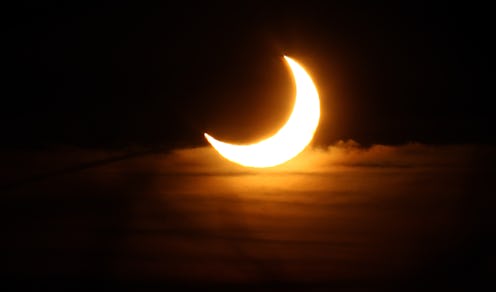Life
Here’s How Much Of The Sun You’ll See Blocked Out During Tomorrow’s Partial Solar Eclipse

Between the super blue blood moon lunar eclipse Jan. 31, the Chinese Lunar New Year, and the upcoming partial solar eclipse, 2018 has already been a busy year, cosmically speaking. While the sun was totally obscured during the August 2017 total solar eclipse, during a partial solar eclipse, how much of the sun is visible? The upcoming partial solar eclipse on Feb. 15, 2018 can be viewed from Antarctica, parts of Pacific and Atlantic oceans (like if you happen to be on a cruise), and southern South America. But, how much of the sun you'll see depends on where you are.
"A partial solar eclipse occurs when only the penumbra (the partial shadow) passes over you," SPACE.com explained. "In these cases, a part of the sun always remains in view during the eclipse." Part of the sun is always visible during a partial solar eclipse because the sun, moon, and Earth don't align completely the way they do during a total solar eclipse, according to Time and Date. "Sometimes, the moon covers only a tiny part of the sun's disk.
Other times a partial eclipse looks almost like a total eclipse. The size of the eclipsed area is referred to as eclipse magnitude." What's more, a solar eclipse can only happen during a new moon, and always follows a lunar eclipse, like the recent super blue blood moon lunar eclipse.
However, not every new moon results in a solar eclipse, which is why we don't have one every month. "This is because the plane of the moon's orbital path around our planet is inclined at an angle of approximately [five degrees] to Earth's orbital plane around the sun, the ecliptic," Time and Date noted. "The points where the [two] orbital planes meet are called lunar nodes. Solar eclipses occur only when a new moon takes place near a lunar node."
The amount of sun you'll be able to see during the partial solar eclipse depends on where you are in relation to its path. And, many other variables can determine how much of the sun you'll be able to see. "Usually the penumbra gives just a glancing blow to our planet over the polar regions; in such cases, places far away from the poles but still within the zone of the penumbra might not see much more than a small scallop of the sun hidden by the moon," SPACE.com explained.
Right about now I'm wishing I'd paid more attention is my college astronomy class because, apparently, even a total eclipse can look like a partial eclipse to some people #TheMoreYouKnow. It's like that experiment where everyone gets blindfolded, touches a different part of an elephant, and reports a completely different idea of what they think it is. "In a different scenario, those who are positioned within a couple of thousand miles of the path of a total eclipse will see a partial eclipse."
According to Time and Date, you won't be able to see the partial solar eclipse at all in North America. However, if you're planning a getaway to South American in the next few days, you're in luck. "The best place to see the event from land will be near the southern tip of South America. For instance, the eclipse will cover up to 40 percent of the sun over the city of Ushuaia, Argentina, while Buenos Aires will get to see only 17 percent coverage," National Geographic reported.
If you're having major FOMO about missing out on this celestial event, you're not alone. There won't be another solar eclipse visible in the U.S. until 2024, with others following in 2033, 2044, 2045, 2052, 2078, 2079, 2097, and 2099. While not all parts of the country will be able to see every eclipse, the April 8, 2024 total solar eclipse, which will be visible to almost everyone in North America, isn't too far off, according to SPACE.com.
So, fear not my friendlies, you will indeed get another opportunity to see a solar eclipse in your lifetime. And, if we all become computer operated beings like in the new Netflix series Altered Carbon, you can just get a new body and enjoy all of the 21st Century eclipses. Hey, if I've learned one thing from Donald Trump getting elected president, it's that anything is possible.